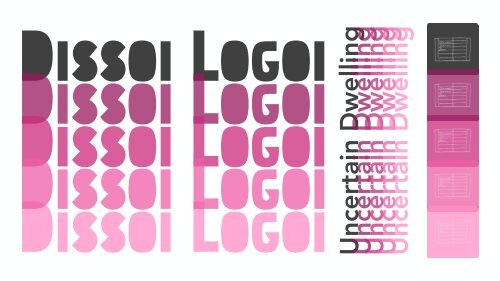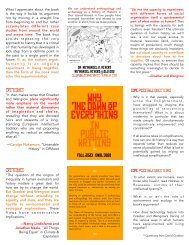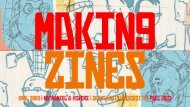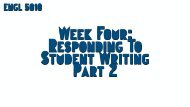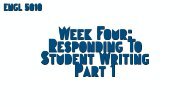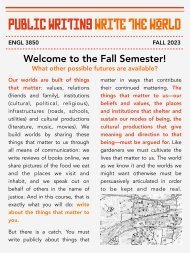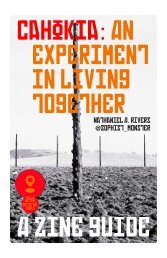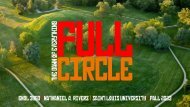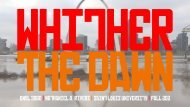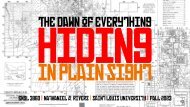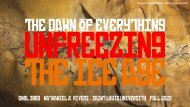ENGL 5010: Week Three/Thursday Slide Deck
Create successful ePaper yourself
Turn your PDF publications into a flip-book with our unique Google optimized e-Paper software.
Dissoi Logoi<br />
Dissoi Logoi<br />
Dissoi Logoi<br />
Dissoi Logoi<br />
Dissoi Logoi<br />
Uncertain Dwelling<br />
Uncertain Dwelling<br />
Uncertain Dwelling<br />
Uncertain Dwelling<br />
Uncertain Dwelling
Introduction<br />
It is not a standard argument paper for which you formulate a thesis<br />
(e.g., smartphones are destroying a generation; we should upload our<br />
consciousnesses into the cloud; Train is the worst band ever). Nor is this<br />
project asking you to support those theses with three main points. In<br />
fact, you will be penalized if you produce a main thesis statement or<br />
claim. The idea of this project is not to come to a single conclusion,<br />
but to think through various possible conclusions as rigorously as<br />
possible.
dissoi logoi rationale<br />
1. There was the basic practical idea that arguing both sides makes you learn your own<br />
arguments better.<br />
2. But there is a more important (though related) reason for practicing the Dissoi Logoi,<br />
which is to acknowledge that there are arguments, or differences, in the first<br />
place.<br />
3. Finally, another reason, which seems more important than ever: thinking through<br />
multiple sides develops your moral imagination.<br />
The point of this project is to dwell in uncertainty. That is, the idea is simply to live<br />
with the possibility that there can be diverse responses to a complex issue, all of which<br />
can be argued with vigor and honesty.
The project<br />
Introduction. In an introduction (which should run no more than a page<br />
(approximately 350 words) and include a couple of paragraphs), you<br />
should outline the human practice (or concept) that you want to start<br />
investigating in response to the readings you’ve been doing. Articulate<br />
the human practice (or concept) you are investigating, explaining how<br />
you came to it or what prompted it, and discuss its importance. Unlike<br />
the introduction of a traditional essay, this one should not conclude in a<br />
thesis statement. But the reader should be able to see clearly what<br />
human practice you’re tracing.
The project<br />
Body. This section can be approached in a couple of different ways. Perhaps<br />
you want to write (at least) three mini-essays, each taking up, in turn, the<br />
consequences of a particular technology (a tool, a procedure, an environment).<br />
Perhaps you want to write a single essay that toggles back and forth between<br />
three or four technologies—describing their scope and impact—without finally<br />
endorsing either. Perhaps neither of these will work because you feel that the<br />
simple pro-con structure is too simple for what you’re trying to do. That’s fine.<br />
Bring in multiple technologies. In addition, you should be bringing in your<br />
sources. All the quoting, paraphrasing, and summarizing you’ve been doing in<br />
your notes and short assignments should make their way into the body section.
The project<br />
Conclusion. Finally, in a page or so (or a couple of paragraphs), discuss<br />
what you might still need to know, reflect upon, and investigate to come<br />
to some conclusion about the question you’re asking (somewhere down<br />
the road). The idea here is to ask yourself what further research you<br />
need to do. If we were to decide amongst these technologies, how<br />
should we go about doing so? Given that technologies not only respond<br />
to but also structure our desires, how can we decide (literally) among<br />
technologies?
The project<br />
It is not required—nor would it be practical in many cases—to present<br />
every possible stance relative to the human practice you have identified.<br />
But you must present at least three; otherwise, it wouldn’t be a dissoi<br />
logoi. And here’s the fun part: to earn the highest marks on this project, I<br />
should not be able to tell which technologies you might favor. You<br />
should be able to present each technology with equal vigor and<br />
eloquence.
Dissoi dissoi logoi<br />
And it’s even more complicated than that, or at least we are making it so.<br />
We can understand the dissoi logoi project itself in terms of the dissoi<br />
logoi: that is, there are multiple ways of going about it. I want to here<br />
quickly juxtapose the two in order to indicate why one is more preferable<br />
for us in this particular instance. <br />
• Multiple Perspectives<br />
• Multiple Practices
Dissoi dissoi logoi: Multiple Perspectives<br />
One standard approach is to treat<br />
the dissoi logoi as an exploration<br />
and articulation of multiple<br />
Perspective 1<br />
perspectives. In this instance, the<br />
different perspectives are all<br />
organized around a singular thing or<br />
issue. That is, the perspectives are<br />
Perspective 4<br />
Human Practice<br />
Perspective 2<br />
m u l t i p l e , b u t t h e y a r e a l l<br />
perspectives on the same thing.<br />
Perspective 3<br />
Figure 1. Multiple perspectives model.
Dissoi dissoi logoi: Multiple practices<br />
There is another way: a way that<br />
raises the stakes of the dissoi logoi<br />
project a little more. In this version,<br />
w e d o n ’ t h a v e m u l t i p l e<br />
Technology 1 Technology 2 Technology 3 Technology 4<br />
perspectives on the same thing,<br />
but different (actual) versions of<br />
the thing that correspond to<br />
different practices. In our course,<br />
Human<br />
Practice<br />
Human<br />
Practice<br />
Human<br />
Practice<br />
Human<br />
Practice<br />
what this means is that different<br />
technologies don’t generate different<br />
perspectives on one thing but<br />
Figure 2. Multiple practices model.<br />
different versions of that thing. In this<br />
model, the thing itself is far from<br />
settled and is at stake through<br />
each technology.
Dissoi Logoi<br />
Dissoi Logoi<br />
Dissoi Logoi<br />
Dissoi Logoi<br />
Dissoi Logoi<br />
Proposal Mapping<br />
Proposal Mapping<br />
Proposal Mapping<br />
Proposal Mapping<br />
Proposal Mapping
Mapping dissoi logoi<br />
For my Dissoi Logoi paper I want to look into the human practice of treating mental health disorders. I<br />
am interested in the different way different professionals approach these issues and what treatments<br />
actually get the desired result. Many people use technology to treat mental health and I want to look into<br />
each of these and see what out comes are produced by each. One technology used in treating mental<br />
health are one on one therapy sessions through video and text. I will talk about how this is an affordable<br />
solution to those cannot pay to see therapists in person or cannot transport themselves to a professional.<br />
Another technology is behavior trackers that work to improve people’s moods. Virtual reality is another very<br />
important technology that is often used to treat PTSD. The last one I want to talk about is the smart<br />
software that finds at-risk patients in medical records. This helps make mental health services more<br />
affordable by finding the correct insurance policy for that person. These are just a few of the technologies I<br />
could focus on. I am going to think about replacing one of these with EDMR Therapy because it is<br />
important. I will probably format my paper to talk about each technology and the benefits it has on mental<br />
health. Then I will pick one at the end. I simply just want my audience to understand the great things about<br />
each one. I might add charts or pictures of each type of treatment to give visuals as to what these<br />
technologies look like.
Mapping dissoi logoi<br />
For my Dissoi Logoi paper I want to look into the human practice of treating mental health disorders. I<br />
am interested in the different way different professionals approach these issues and what treatments<br />
actually get the desired result. Many people use technology to treat mental health and I want to look into<br />
each of these and see what out comes are produced by each. One technology used in treating mental<br />
health are one on one therapy sessions through video and text. I will talk about how this is an affordable<br />
solution to those cannot pay to see therapists in person or cannot transport themselves to a professional.<br />
Another technology is behavior trackers that work to improve people’s moods. Virtual reality is another very<br />
important technology that is often used to treat PTSD. The last one I want to talk about is the smart<br />
software that finds at-risk patients in medical records. This helps make mental health services more<br />
affordable by finding the correct insurance policy for that person. These are just a few of the technologies I<br />
could focus on. I am going to think about replacing one of these with EDMR Therapy because it is<br />
important. I will probably format my paper to talk about each technology and the benefits it has on mental<br />
health. Then I will pick one at the end. I simply just want my audience to understand the great things about<br />
each one. I might add charts or pictures of each type of treatment to give visuals as to what these<br />
technologies look like.<br />
Picking one at the end critically undermines<br />
the goal of the dissoi logoi project.
Mapping human Wants<br />
The human practice I will be investigating is privacy. I will be focusing on the security of information<br />
stored on smart devices by users (consumers). My plan is to consider the different privacy concerns held<br />
by users and the response of big technological companies that have faced controversy regarding privacy<br />
and security. The first technology I will be researching is iCloud. iCloud, a cloud storage service created by<br />
Apple, is thought to be highly secure. Apple is a company famous for placing high priority on the privacy<br />
and security of not only iCloud, but all their devices. They have faced controversy because of this<br />
dedication to security. The second technology I will be researching is Google Drive. I plan to research the<br />
general experience of its consumers, as well as significant breaches that have occurred. Because this is a<br />
Dissoi Logoi, I will also be researching any breaches that Google Drive has thwarted/the positive<br />
experiences users have had. The third technology I will be researching is Dropbox. Similar to that of Google<br />
Drive, I will be researching the general experience of its consumers, significant breaches, and positive<br />
experiences. All three technologies that I am researching on three separate companies highly competitive<br />
towards one another. My Dissoi Logoi will be in the form of a regular paper. So essentially, I will be writing a<br />
single essay that goes back and forth between the three technologies mentioned previously. I will be<br />
comparing and contrasting all three technologies without endorsing a particular one.
Mapping human Wants<br />
The human practice I will be investigating is privacy. I will be focusing on the security of information<br />
stored on smart devices by users (consumers). My plan is to consider the different privacy concerns held<br />
by users and the response of big technological companies that have faced controversy regarding privacy<br />
and security. The first technology I will be researching is iCloud. iCloud, a cloud storage service created by<br />
Apple, is thought to be highly secure. Apple is a company famous for placing high priority on the privacy<br />
and security of not only iCloud, but all their devices. They have faced controversy because of this<br />
dedication to security. The second technology I will be researching is Google Drive. I plan to research the<br />
general experience of its consumers, as well as significant breaches that have occurred. Because this is a<br />
Dissoi Logoi, I will also be researching any breaches that Google Drive has thwarted/the positive<br />
experiences users have had. The third technology I will be researching is Dropbox. Similar to that of Google<br />
Drive, I will be researching the general experience of its consumers, significant breaches, and positive<br />
experiences. All three technologies that I am researching on three separate companies highly competitive<br />
towards one another. My Dissoi Logoi will be in the form of a regular paper. So essentially, I will be writing a<br />
single essay that goes back and forth between the three technologies mentioned previously. I will be<br />
comparing and contrasting all three technologies without endorsing a particular one.<br />
The goal is not to measure the technologies against some prior notion of<br />
privacy but instead to trace how each technology defines privacy itself.
Mapping human Wants<br />
My dissoi logoi will investigate the means by which humans produce energy. The world is changing, and<br />
so is our need for energy, but which energy source wants what is best for us? Economics, pollution, safety,<br />
and dependability are all factors of energy production that play for us or against us. The 5 technologies I<br />
will be researching are wind, solar, nuclear, hydro, and “combustion” which is basically a bunch of things we<br />
burn the generate electricity, like coal, oil, and gas. Wind and solar are technologies that are both<br />
renewable, clean, and depend entirely on the conditions of the environment to generate<br />
electricity. Hydroelectric dams are also a clean and renewable means of generating electricity, that don’t<br />
rely so heavily on the day to day environment. They are, however, very detrimental to aquatic life. Nuclear<br />
energy is considered clean as it only lets off steam into the atmosphere, but toxic nuclear waste is<br />
a byproduct of this process. It is however a nonrenewable means of producing energy. Lastly, the<br />
combustible means of energy are most of what power this planet today. They have lots of infrastructure<br />
already in place, it is cheap, and provides a lot of jobs to uneducated workers. However, they are also very<br />
heavy polluters. The dissoi logoi paper will take the form of breaking down the wants of each energy<br />
source, focusing on one energy source in each paragraph. Then comparing them with the perceived wants<br />
of the human race, and see how they individually line up with or against where we want to go as a species.
Mapping human Wants<br />
My dissoi logoi will investigate the means by which humans produce energy. The world is changing, and<br />
so is our need for energy, but which energy source wants what is best for us? Economics, pollution, safety,<br />
and dependability are all factors of energy production that play for us or against us. The 5 technologies I<br />
will be researching are wind, solar, nuclear, hydro, and “combustion” which is basically a bunch of things we<br />
burn the generate electricity, like coal, oil, and gas. Wind and solar are technologies that are both<br />
renewable, clean, and depend entirely on the conditions of the environment to generate<br />
electricity. Hydroelectric dams are also a clean and renewable means of generating electricity, that don’t<br />
rely so heavily on the day to day environment. They are, however, very detrimental to aquatic life. Nuclear<br />
energy is considered clean as it only lets off steam into the atmosphere, but toxic nuclear waste is<br />
a byproduct of this process. It is however a nonrenewable means of producing energy. Lastly, the<br />
combustible means of energy are most of what power this planet today. They have lots of infrastructure<br />
already in place, it is cheap, and provides a lot of jobs to uneducated workers. However, they are also very<br />
heavy polluters. The dissoi logoi paper will take the form of breaking down the wants of each energy<br />
source, focusing on one energy source in each paragraph. Then comparing them with the perceived wants<br />
of the human race, and see how they individually line up with or against where we want to go as a species.<br />
The goal is not to measure the technologies against the wants of humans but<br />
instead to trace how human goals are, in part, shaped by these technologies.
Mapping technology Wants<br />
The human activity that I am investigating is the intake of opioids. More so of how opioids are<br />
administered, and how the type of administration effects the wants of the opioid. The route of<br />
therapy of opioid administration is a key consideration when choosing specific agents. The most<br />
common route is the oral route, which is easy and generally cheap. However, it is short acting and often<br />
takes longer to reach the peak effectiveness. Another route is the transdermal route, which provides a<br />
simple, comfortable method that allows for stability in concentrations. However, this route has a slow<br />
onset, so patients with acute pain cannot use it, and is expensive. The intravenous (IV) route is an<br />
additional method of administration. This method allows for a continuous infusion of opioids but is<br />
complicated because it requires prolonged venous access and close supervision. Another route for<br />
administration is the subcutaneous route, where the medication in injected under the skin. This allows<br />
for a quick delivery, but also causes local toxicity, requiring the injection site to be changed frequently.<br />
For the dissoi logoi, arguments for and against opioids and their administration can be made. Each type<br />
of administration obviously has their own advantages and disadvantages, which would help make strong<br />
opposing arguments for the administration of opioids and what it wants.
Mapping technology Wants<br />
The human activity that I am investigating is the intake of opioids. More so of how opioids are<br />
administered, and how the type of administration effects the wants of the opioid. The route of<br />
therapy of opioid administration is a key consideration when choosing specific agents. The most<br />
common route is the oral route, which is easy and generally cheap. However, it is short acting and often<br />
takes longer to reach the peak effectiveness. Another route is the transdermal route, which provides a<br />
simple, comfortable method that allows for stability in concentrations. However, this route has a slow<br />
onset, so patients with acute pain cannot use it, and is expensive. The intravenous (IV) route is an<br />
additional method of administration. This method allows for a continuous infusion of opioids but is<br />
complicated because it requires prolonged venous access and close supervision. Another route for<br />
administration is the subcutaneous route, where the medication in injected under the skin. This allows<br />
for a quick delivery, but also causes local toxicity, requiring the injection site to be changed frequently.<br />
For the dissoi logoi, arguments for and against opioids and their administration can be made. Each type<br />
of administration obviously has their own advantages and disadvantages, which would help make strong<br />
opposing arguments for the administration of opioids and what it wants.<br />
This dissoi logoi looks at what each administration technique does and wants. Researching what<br />
each technique wants, leaves us better prepared to make decisions, which comes next.
Mapping form<br />
The human practice that I will be investigating will be cooking and the handling of food. The culinary<br />
context of technology will be focused on, including heating for preparation, the process of directly cooking<br />
the food before it is served, and the different fields of cooking, from grilling to baking. The first technology<br />
being researched is the microwave, which is used for warming any food that has gotten cold and for creating<br />
instant meals from pre-made packages. Quick and simple to use, they have a limited amount of potential for<br />
use and are treated as inferior tools in the culinary world. The second observed machine is the oven, most<br />
commonly associated with baking and known for its use of indirect dry heat to create dishes. As its chamber<br />
ranges from roasting to heating ingredients, it faces a variety of methods for cooking, and are accompanied<br />
by upper burners for boiling. The final studied device is the grill, known for its direct application of dry heat to<br />
greasy food. It has less varied use but is responsible for many steaming dishes that allow for better taste and<br />
is frequently used in the kitchen. The Dissoi Logoi could take the form of a journalistic entry similar to articles<br />
seen in newspaper publications or even magazines. It will present the differing views and opinions regarding<br />
each device and compare them over their main goal of cooking. Ideas will come from professional chefs to<br />
common consumers.
Mapping form<br />
The human practice that I will be investigating will be cooking and the handling of food. The culinary<br />
context of technology will be focused on, including heating for preparation, the process of directly cooking<br />
the food before it is served, and the different fields of cooking, from grilling to baking. The first technology<br />
being researched is the microwave, which is used for warming any food that has gotten cold and for creating<br />
instant meals from pre-made packages. Quick and simple to use, they have a limited amount of potential for<br />
use and are treated as inferior tools in the culinary world. The second observed machine is the oven, most<br />
commonly associated with baking and known for its use of indirect dry heat to create dishes. As its chamber<br />
ranges from roasting to heating ingredients, it faces a variety of methods for cooking, and are accompanied<br />
by upper burners for boiling. The final studied device is the grill, known for its direct application of dry heat to<br />
greasy food. It has less varied use but is responsible for many steaming dishes that allow for better taste and<br />
is frequently used in the kitchen. The Dissoi Logoi could take the form of a journalistic entry similar to articles<br />
seen in newspaper publications or even magazines. It will present the differing views and opinions regarding<br />
each device and compare them over their main goal of cooking. Ideas will come from professional chefs to<br />
common consumers.<br />
This more journalistic style allows for descriptions of the<br />
experiences of cooking that each technology wants. Such a form<br />
works well for this topic (but not necessarily all topics).


